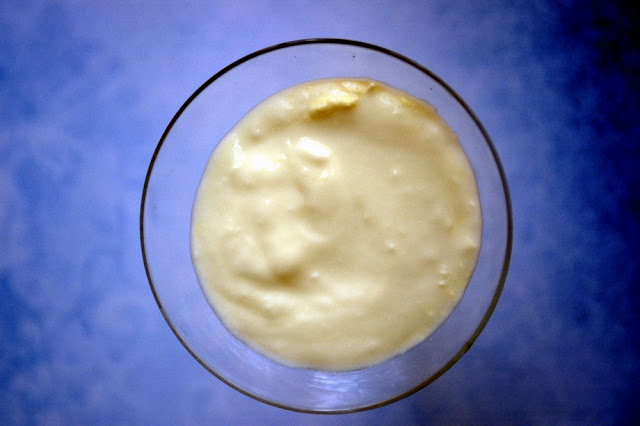Easy Peasy Homemade Yogurt
We go through a lot of yogurt in our house ... so much, in fact, that I seriously considered buying a share in an organic cow. Well, not really ... but it did give me reason to start making my own.
I do this the easy way, and on the cheap. Whenever I see organic milk marked down at the shop I buy up. Then I make some organic plain yogurt to the tune of 4 L for $3 to $4. (Incidentally, that's about 1/7th of normal price). It stores well, and tastes amazing ... and I can add jam or honey to sweeten it up. But there's nothing in there but milk and culture, and I love that!
(Nelle does too)
***********
Easy Peasy Homemade Yogurt
makes 2L
The time
20 min heating + 30-60 min cooling + o/night culturing
(but hardly any time actually standing there doing stuff)
The ingredients
2 L milk (whole milk is yummiest)
4 Tbs milk powder (optional - it just makes the yogurt thicker)
1/2 c yogurt (from a previous batch or store-bought)
*Use organic milk if you can ... and if you can get unpasteurised - even better!
+ a cooking thermometer
+ glass jars with lids - I recycle store-bought jam/cream/sauce jars for this
+ lovely thrifted cocktail glasses, for serving
The process
1. Slowly heat up the milk and milk powder in a large, stainless steel pan to 85-90C (185F). I do this on medium heat and just leave it for the first 15 min or so ... then as it starts to get hotter I attend to it with a whisk to make sure it doesn't burn on the bottom of the pan.
2. When the milk hits 85-90C, take it off the heat and cover until it cools to 50C (120F).
3. Meanwhile, sterilise your jars and lids by washing them in hot, soapy water and then drying them in an oven set to 60C (140F) for 20-30 min.
4. When the milk has cooled to 50C (120F), ladle out 1/2 c and mix it with 1/2 c of yogurt. It's best to use fresh yogurt for this ... like opening your last jar of the previous batch. Now and then you'll have to refresh with store-bought yogurt, just to keep the cultures at their best.
5. Mix the yogurt/milk mixture back into the pan of milk, stirring well. This is where you distribute the yogurt cultures through the whole volume of milk.
6. Turn off the oven, and take your jars out. Ladle the contents of the pan into them, one by one. Fill them up almost to the top, tightly lidding them as you go.
7. When the oven is mostly cool, wrap the yogurt jars in a thick towel and put them into it. Leave overnight (or around 12 hrs, if you're doing this in the morning). Whatever you do, don't turn on the oven! I just find the oven a warm, draft-free place for the cultures to do their thing. Feel free to use a cupboard or cooler or esky or whatever if you prefer.
8. When they're done, they should be nice and thick and (probably) the lids will be vacuum sealed. Store in the fridge for up to a couple of weeks. I haven't had a sealed homemade yogurt go off yet ... but I can't say it doesn't happen. Just use your best judgement.
My organic homemade yogurt usually costs me around $0.75 - $1 per litre.

************
Dish of the Day
This is a little bit of a cheat, because I've actually featured these glasses before on my other (now-retired) site. But hey, when you find a set of 5 lovely cocktail glasses at a thrift store for $1.50 for the set ... well, it's worth showing off. (You can check out other thrifty finds here)
I haven't actually used these for cocktails yet, would you believe? But I do use them for dessert ALL the time. They're perfect for dressing up simple things, like yogurt or fruit. And ideal for an ice cream + sauce combo.
And when things get hairy late in the afternoon, when Nelle's too tired for words and the tantrums come thick and fast ... I can fill a glass with yogurt and pretend to sip a much-needed martini.
Ah, that's better.
Amanda xx


I can;t get rid of taking it everytime i see some. So yummy!
ReplyDeleteHow would you make greek yoghurt? and, Do you have to use jars and vacuum seal the lids? Is there a way to pour it into a bowl somehow and let it set in the fridge? (As you can see, I know nothing about yoghurt making but I am very interested.) Can you reuse the lids or do you have to buy new ones each time?
ReplyDeleteHi Amanda, linked your post to my Greek yoghurt one... not skilled enough to know how to give it a proper backlink, or if that is even possible on Blogger! Here you go:
ReplyDeletehttp://www.thedishylife.com/2011/07/homemade-greek-yoghurt.html
@beverlymm
ReplyDeleteHi Beverlymm, just noticed your comment! I make greek yoghurt by straining it through muslin cloth... removes excess liquid, leaving it super creamy.
Hope this helps!
Thanks Bec! Lovely!
ReplyDeleteDo you leave the light on in the oven? Other recipes I've seen for yogurt say to do this.
ReplyDeleteI dug my spoon in last night just to check (almost too easy to believe) ... awesome! It now makes the labneh even more practical and cheap!! Thanks! ... question ... how often (and why?) do you need to replace the starter batch with fresh yogurt?
ReplyDelete@Matthew Gasperoni Hi - I've read that you should refresh after 5 or so batches, but I bet that's pretty arbitrary. Whenever it suits you to refresh before then would probably work. Personally, I tend to forget and then run out of yogurt ... so I end up buying a new batch and starting all over anyway :)
ReplyDelete